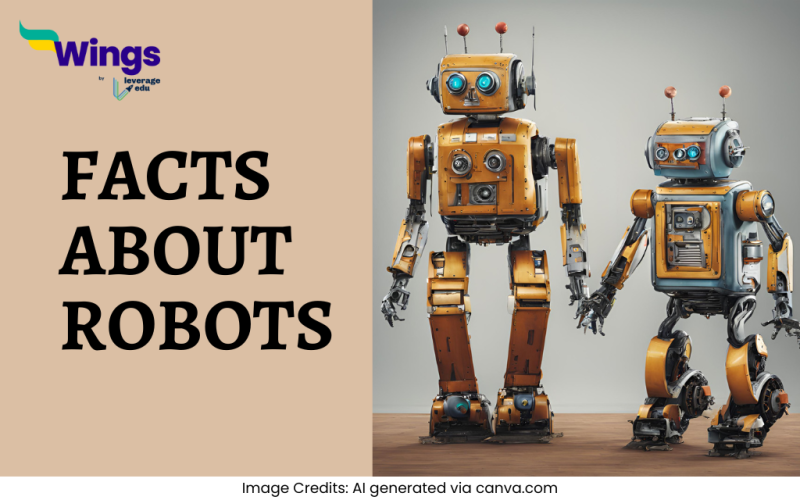Facts about robots are fascinating and show how these machines have revolutionized the way we live and work. While some robots like Sophia are designed to resemble human features, others look like machines crafted for specialized functions only. Robotics Engineering is a field of study that deals with designing and creating robots. Moreover, people of all ages are fascinated by the idea of robots facilitating every aspect of human life. To quench your thirst for knowledge, here are some interesting fun facts about robots.
1. The term “robot” comes from the Czech word “robot”
Table of Contents [show]
The word “robot” is derived from the Czech term “robota,” meaning “forced labor” or “front duty.” It was first used to describe artificial beings in the early 20th century and symbolizes the idea of machines taking over tasks traditionally done by humans, often in a repetitive or labor-intensive way.
2. The word “robot” was first used in a play called RUR
The term “robot” was introduced to the world through Karel Čapek’s 1920 play R.U.R. (Rossum’s Universal Robots). The play depicted robots as artificial, human-like workers who eventually rebel against their creators, which sparked discussions about the ethical and moral implications of robotics.
3. Isaac Asimov created the “Three Laws of Robotics”
Isaac Asimov, a famous science fiction writer, introduced the “Three Laws of Robotics” in his short story Runaround. These laws were designed to ensure robots would be safe to use and would act in ways that would prevent them from harming humans, laying the groundwork for modern robotics ethics.

4. Leonardo da Vinci designed a mechanical knight in 1495
In 1495, Leonardo da Vinci sketched detailed plans for a mechanical knight, which he envisioned to have human-like movements. His design was based on the structure of the human body and aimed at creating a machine capable of sitting, waving its arms, and moving its head, showing an early concept of automation.
5. Joseph F. Engelberger is known as the father of robotics
Joseph F. Engelberger, an American physicist and engineer, is recognized as the father of robotics. He co-founded Unimation, the first company to develop industrial robots, and played a crucial role in bringing robots into the manufacturing industry during the 1950s and 1960s.
6. Shaky was the first mobile and perceptive robot
Developed by SRI International in Silicon Valley, Shaky was the first robot that could move autonomously and perceive its surroundings. This groundbreaking technology, introduced in the 1960s, allowed Shaky to make decisions based on the environment, laying the foundation for modern robotics.

7. Unimate was the first industrial robot
Unimate, created by George Devol and Joseph Engelberger in 1961, became the first industrial robot to be used in a factory setting. It was introduced in a General Motors plant to handle repetitive tasks, marking a major milestone in the integration of robots into manufacturing.
8. Japan was the first to manufacture and sell robots
Japan is known as the first country to develop, manufacture, and sell robots on a large scale. With its strong emphasis on technology and innovation, Japan became a leader in robotics, particularly in the fields of industrial robots and personal assistant robots.
9. The first death caused by a robot occurred in 1981
In 1981, a Japanese factory worker tragically became the first recorded person to be killed by a robot. The worker’s arm was crushed by a robot arm in a factory, raising important concerns about robot safety and prompting more regulations for workplace robotics.
10. NASA has sent five robotic vehicles to Mars
NASA has successfully sent five robotic rovers to Mars: Sojourner, Spirit, Opportunity, Curiosity, and Perseverance. These rovers have explored the Martian surface, sending valuable data back to Earth and helping scientists learn more about the planet’s potential for life.
11. Robots were created to replace human labor
Robots were originally created to take over repetitive and physically demanding tasks that humans would find tiring or dangerous. These machines are designed to improve efficiency and reduce the workload on humans, especially in industries like manufacturing, agriculture, and healthcare.

12. Humanoid robots resemble humans in appearance and behavior
Humanoid robots are designed to look and behave like humans. A popular example is Lieutenant Commander Data from Star Trek, who has human-like features and can interact with other crew members. These robots are built for various tasks, including customer service and research.
13. Robots like Pepper act as domestic helpers in Japan
In Japan, robots such as Pepper have become part of daily life, especially as helpers in homes and businesses. These robots can perform tasks like assisting with chores, providing entertainment, or offering companionship, making life easier for people, especially the elderly.
14. Sophia is the first robot to have citizenship
Sophia, a humanoid robot created by Hanson Robotics, made history by becoming the first robot to be granted citizenship by a country. Saudi Arabia awarded her citizenship in 2017, marking a significant moment in the intersection of technology and legal rights.

15. Robots use sensors to see and hear
Robots are equipped with cameras and sensors that allow them to perceive their environment, similar to how humans use sight and hearing. These sensors help robots navigate spaces, recognize objects, and make decisions based on what they “see” and “hear,” making them more autonomous.
16. Vacuum robots are the most common household robots
Vacuum robots, like Roomba, are among the most widely used robots in households. These robots can autonomously clean floors by navigating around obstacles, detecting dirt, and vacuuming without needing human intervention, making housework easier for everyone.

17. Robophobia is the fear of robots
Robophobia is the extreme fear of robots, drones, or robot-like machines. This fear can stem from concerns about technology replacing human jobs, the potential danger of robots, or just the unfamiliarity with such advanced machines, making it a growing psychological challenge in a tech-driven world.
18. Kevin Warwick implanted a microchip in his nervous system
In 1998, Professor Kevin Warwick from Reading University became the first person to implant a microchip into his nervous system. This allowed him to control devices like lights and elevators, demonstrating the potential for merging technology with the human body to create “cyborgs.”
19. Elektro is the oldest surviving American robot
Elektro is considered the oldest surviving American robot, built in 1939 by Westinghouse Electric. It was showcased at the New York World’s Fair and could perform basic tasks like speaking, moving, and waving, providing an early glimpse into the future of robotics.

20. Nanobots are tiny robots designed for small spaces
Nanobots are microscopic robots designed to work in very tiny spaces, often on the scale of cells or molecules. These bots could be used for medical purposes, such as delivering drugs directly to specific areas of the body, or for repairing tissues at the cellular level.
21. Robear is a robot designed to assist with personal care
Developed by Riken Institute and Sumitomo Riko, Robear is a personal care robot with a cute, bear-like face. It is designed to help elderly or disabled people by assisting them with tasks like transferring from a wheelchair to a bed, making it a helpful tool in healthcare.
FAQs
5 facts about robots include that robots don’t need breaks and can work non-stop, they are ideal for repetitive or dangerous tasks in factories and assembly lines, and many robots are equipped with sensors that help them see, hear, and even feel, humanoid robots are designed to look and act like humans, and lastly, some robots can learn new tasks by observing humans or through trial and error.
It is believed that the first robot was created by George Devol in 1954. It was called Unimate, and it was the first robot to be digitally operated and programmable.
What makes robots special is their ability to perform tasks with precision and efficiency. Robots don’t get tired or make mistakes from fatigue, making them perfect for jobs that require consistency, like in factories.
Some positive facts about robots are that they can perform repetitive tasks quickly, they are faster and more accurate, they can take over dangerous tasks, and assist in surgeries and patient care.
Robots are widely used in manufacturing, healthcare, space exploration, agriculture, education, and home assistance.
The Father of Robotics is Joseph F. Engelberger. He was an American physicist, engineer, and businessman who played a huge role in developing industrial robots and transforming the robotics industry.
Interesting Reads
Hope you enjoy reading these facts about robotics. If you want to know more about topics like this, then visit our Interesting Facts and General Knowledge page!
 One app for all your study abroad needs
One app for all your study abroad needs















 45,000+ students trusted us with their dreams. Take the first step today!
45,000+ students trusted us with their dreams. Take the first step today!
